Raven’s Last Rambler
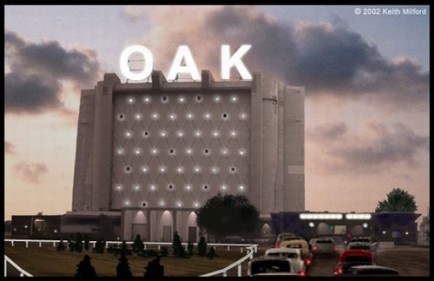
(The celebrated Oak Drive-In Theater, now sadly demolished in the interest of progress. Photo Keith Milford).
It was a day for drive-ins. No, not what you are thinking- we will get back to a discussion of the real way to enjoy a film- or something even more exciting one of these days- and take a tour the passion pit that was The Oak Drive in in Royal Oak, Michigan.
August is the time for people to drive their cars to fields and parking lots and let folks take a look at their rolling treasures. There were some great Rambler Americans on display from one of the oldest places in the country- Kilmarnock, on Virginia’s historic Northern Neck:
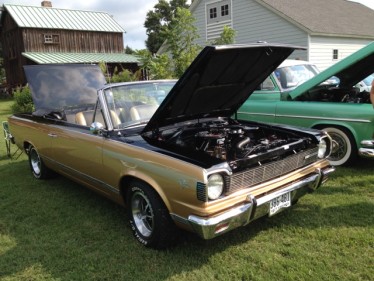
(1968 Rambler American convertible in cherry condition and custom paint at a drive-in event on the Northern Neck. Photo Jacoby).
Car events are happening all across the country- it is the time. From our seasoned correspondent Mules come these images of the 2014 Concours D’LeMons:
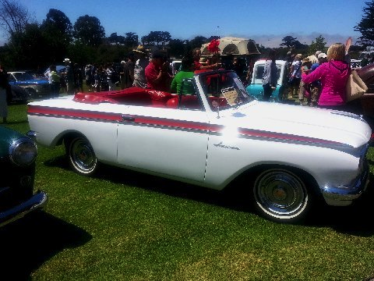
(We had the sedan model of this trim little 1962 American. Fuel efficient and fun to drive for Big Mama. Concours D’LeMons photos by Mules).
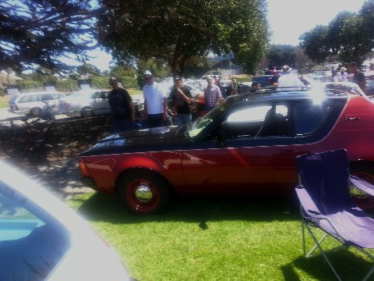
(We were one of the few three-Gremlin families I knew. Amazing little rides- I had to keep re-paining the one in metallic gray for some reason. AMC design Chief Dick Teague drew the concept on the back of an airsickness bag on a long flight back from the coast. Teague’s long career is what caused Raven to jump to appliance design, since it was apparent he could never move up to replace him).
Mules said the Seaside, CA, Concours D’LeMons had a good crowd and was a great event, and I believe it. The show celebrates “the Oddball, Mundane, and Truly Awful of the Automotive World. It is in deliberate counterpoint to the auctions where a rare Ferrari can go for a few dozen millions, and showcases some fo the stuff real people drive in the real world.
Former late night talk show host and King of the Car Guys, Jay Leno liked it to. You will see behind the famous profile an AMC Pacer, one of the most bizarre rides on the road in its day.
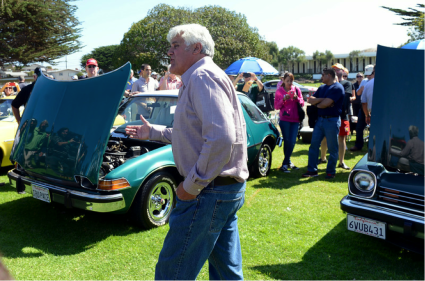
I got lost in a reverie of the old cars, and it occurred to me that Raven’s last Rambler was a memorable one, too, and it would have been fun to hang onto.
Raven’s last real car was Chrysler PT Cruiser, which he loved dearly until that incident with the deer over by Harbor Springs. But the last car he had was a present from Spike.
I invite my brother to contribute the story of the genesis of the 1957 Sedan’s arrival in the Little Village by the Bay. He apparently found it in some lot in Arizona, and it was a clean car, no corrosion like the old cars are riddled with in the upper Midwest from the salt treatment on the winter roads.
Looking back on it, I should have kept the thing when I was in the process of liquidating the estate. But I had to sell the house and get rid of 63 years of married bliss, and the cars had to go. Mom’s little Neon was first, and then the Rambler went. This fuzzy phone picture captures the last time Raven was in a car that he helped to design:
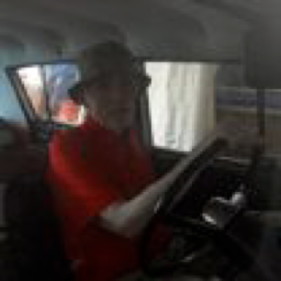
And as much as we love these rolling relics, I have to say that they are big pieces of inconvenient steel when you need to get rid of them.
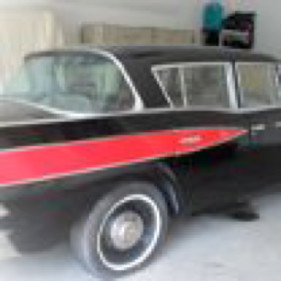
Tires going flat, engine dead as a doornail, seats needed work, but it was mostly all there, trunk full of disassociated parts and trim bits, including the ominous spreading pool of oil underneath.
As Raven began to fail, Big Mama tried to keep things afloat. A local guy was doing some restoration work that they could no longer afford, or really even remember, and she became suspicious that the guy was ripping her off. She was not much of a car person- all she expected from her cars was that they started and got her where she needed to go. So, the massive old car sat silent in the Taj Garage next to the house for years.
If I hadn’t been so busy….
In the end, I called the Purple Heart guys, and they dispatched a wrecker to come and get the thing.
I had mixed feelings when they winched it onto the truck. The wheels were frozen, and it was quite a process for whoever wound up with it. We could use the tax deduction to close things out, I figured, and it was one less thing that had to be managed in the chaos.
But on a lovely August Day, it certainly would have been fun to drive Raven’s Last Rambler to the big show out in Indiana, you know?
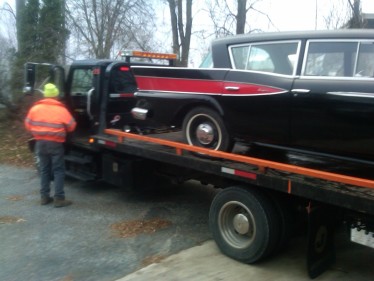
(Raven’s Last Rambler goes to the big showroom in the sky).
Copyright 2014 Vic Socotra
www.vicsocotra.com
Twitter: @jayare303
RAMBLERS AND REBELS:
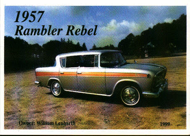
A Tale from the land of Anthracite and Beer
“The REBEL utilized the now familiar large engine in a small body to achieve remarkable performance: 0-60 mph in 7.2 seconds and quarter-mile times below 16 seconds. At Daytona Beach in Florida a REBEL not only produced these impressive performance results, but also outperformed al production sedans and was only beaten by a fuel injected Corvette by 0.2 seconds. Only 1500 REBELs were produced and today, less than two dozen survive. This particular REBEL is serial 1657, and is owned by Dr. W.H.Lenharth, director of the Research Computing Center, University of New Hampshire.” – Literature associated with the REBEL
The line between a hobby and madness is very fine indeed- Dave Berry
My son and I rolled into Pottsville, PA, in the middle afternoon of a summer day in the car-show season of 2000, before everything lurched into crazy. We made a rapid, top-down trip from the nation’s Capital. We stopped in a gas station to tank up- bit remote out there, you know, in the anthracite hills. The gas jockey that materialized next to my car began to open the fuel door.
“Hey, what’s up?” I said. I looked around for the “Full Service” and “Self” signs to see if I had got it wrong.
“Sorry, Sir. We only have full service” said the kid. He looked at my Pentagon parking pass in the windshield. “You must be some kind of Washington big-shot.”
“Yeah” I agreed. “I get to make the coffee because I’m the first one in the office in the morning.”
The kid laughed nervously, and I assumed they didn’t get a lot of pointy-headed bureaucrats in this neck of the woods. But my son and I were on a mission. We were in Pottsville to attend the big Nash Rambler Convention, and listen to my Dad talk about the halcyon days at American Motors to the faithful. I walked around back of the station to smoke a cigarette outside the sight on my son. The place was clean and well kept up, but strictly out of the 1960s. I wandered back out front as he was topping up the tank and checking the oil. He actually knew where to put the metal support rod to keep the hood up- something that I had been delightfully oblivious to until that moment. I thanked him for saving my noggin some dark night hunched over the engine with hood crashing down. Then, the metropolis being somewhat larger than I had expected, I asked him where the big Rambler rally was. He looked at me blankly. Do you mean Pottsville, or Pottstown, Sir?”
My son and I looked at each other in some panic. I swore Dad had said Pottsville, but were we on the wrong end of a very hilly state?
Nick looked at me with the perfect gaze of a 17-year-old confronted by the obvious stupidity of the family alpha male. “I’m almost sure he said Pottsville……shit!”
“Way to go, Dad.”
Gassed and able to restrike Washington on one tank., e piled back into the Sebring and I opined that we might as well head on into town and see what we might find.
Pottsville is a town that you wouldn’t stumble across unless you were going there for a reason. But it was a pleasant surprise. The row houses were well-kept, the park was nice, the cemetery old and dignifies, and as we reached the downtown- and there was a distinct downtown area of classic old brick buildings, and even a few towers stretching to six or seven stories. It looked clean, but down at the heels. Signs advertised the place as being founded in 1808, and home to the oldest operating brewery in America (“Attention, Central Pennsylvania Beer Drinkers! Juengling’s Lager is on sale!”) as well as the best grade of anthracite coal in the region.
The downturn in coal prices probably accounted for the slightly frayed look of the city, but it obviously had been someplace of authority once.. We turned right on one of the main streets, looking for some sort of sign. The buildings were getting shorter and that wasn’t a good sign. My son suddenly shouted that he had a tally on a family all attired in identical “Nash Rambler- Fine American Autos since 1902:” tee-shirts. A wave of relief passed over me with the probability that we would not be driving around coal-seamed valleys long after the light failed.
The hotel where we booked also slid past on the left, and I began to get the sense that we might actually be close. We got to the end of the block and turned left toward Highway 61 (didn’t Bob Dylan revisit this place?). Down in back of the Quality Hotel was the field of dreams. There were about seventy classic old cars all lined up in what had probably once been a warehouse district knocked down in urban renewal frenzy years ago. We slid into the adjacent parking lot and strolled up to find by Dad surrounded by a small crowd of folks listening to his discourse in rapt attention.
“……AMC designer William Reddig was Ed Anderson’s assistant. Reddig designed the trademark “dip” in the roofline of the Rambler station wagon and worked on advanced designs for the Metropolitan as well as the landmark 1956 Rambler. Of his assistant, Anderson said: “He was the best- the very best.” – Pat Foster, American Motors, the Last Independent
Dad was in his element. Camera around his neck, he expounded on how things were when George Romney took the company over from George Mason, and built the first real compact cars to combat the swarms of little beetles from overseas. Dad is literally the last man standing from those days, with only his pal Jim Alexander from the interior styling group still active. But Dad has a certain cachet that makes him an icon. He is the man who made the dip, the distinctive downturn in the roofline of the 1956 Ambassador Station wagon that enabled thrifty George Romney to use the same tooling for the sedan and the wagon- saving significant dollars for the strapped company. It also marked the start of the ultimate drive-in vehicle, since the Rambler wagons had in common with their sedan brethren front seats that reclined to make beds!
Generations of teen-agers forced to endure the ignominy of driving their Father’s Ramblers always had one feature they could be proud of in their cars!
Romney ended 1956 on a hopeful note. He made a moving and dramatic speech to his dealers. His voice rose in emotion. If only 30,000 more units could be sold, the company would turn a profit. If everyone did their best, worked hard, keep an eye on costs, and keep the company afloat, it would all work out…….
It was not to be. 1957 was another losing year, but it showed a trend in the industry that American Motors was ready to exploit. Losses were in the old Hudson and Nash models were fading in their dotage. The Rambler envisioned by Ed Anderson and his young design teams were poised to be the first legitimate compact cars. The market was there. The glory years of 1958-63 were coming. The years in which the stock actually went up, and the benefits for the executives were sublime.
At the beginning of 1958, designer William Reddig was manager of exterior styling for AMC…..
We were only moments into the greeting when Pat Foster, the noted AMC cult author, rolled by in a bizarre 1953 Ambassador, turquoise and deep blue, with enough chrome on the grill and bumpers to plate a zeppelin.
“Hey, Bill,” he yelled through the window “Let’s go for a drive!”
We couldn’t resist. Raven, my son and I piled into the venerable car and were nearly lost in the three-across back seat. The upholstery was in good shape, two-tone, tucked and rolled just like it used to be. No pansy seat belts, either. We slide some ancient Rambler sales brochures onto the painted back deck and Pat lurched off in first gear. “I almost bought this one last year” said Pat to the general audience. Dave, the bespeckled guy in the front right, was apparently the owner. We wheeled across Pottsville, on a mission of some sort.
“This car sort of has a hard shift into second” commented Pat as the transmission curthunked forward. Several minutes of detailed discussion of the peculiarities of the ’53 and ’54 hydro smooth-blaster transmissions followed, including the admonition that the two living Americans who can work on them are suspected of price gouging. I made a mental note that the suspension on this venerable boat also left something to be desired as we took at least a fifteen degree list on each lane change.
It was magnificent to roll through a city where the old people on their porches didn’t even seem to think that we were unusual. That made a lot more sense when we showed up at the destination. There was a garage in the back of a modest home about ten blocks away from the downtown. Over the door was a sign that proclaimed “Rambler Service Center” complete with cobwebs.
We entered the cinderblock structure with a caution from Dave not to kill ourselves by falling down an oil pit. In the dimness were hulks of Nash Country Clubs, a Hudson Hornet, a miraculously preserved Ambassador. Hoods leaned precariously against disemboweled sedans. A riot of parts and chrome strips lay strewn about, covered with a layer of dust. In a side bay, though, a car was positioned under a tight-fitting cover. A classic-car dealer banner over the Bay proclaimed: “Welcome the 1959 Ramblers!”
Dad and Pat walked up to the car, and identified it under the cover by stroking the outline of the fins. “I’d say 1958” said Pat.
“Nope. 1959,” said Dad.
We peeled back the cover and oohed and ahh-ed for a while before taking the drive back to the show. It was getting on to late afternoon, and some cars were already pulling out to Route 61, rambling home. I ached to see a 1968 Javelin chirp the tires going out of the lot- that was the first car I ever drove over 100 miles an hour. We had them all, since executives were entitled to a new car each year, and Dad was with the firm in one capacity or another for nearly 35-odd years. We walked the line, my son and I, and talked about the peculiarities of all the cars I knew, loved and loathed down through the years.
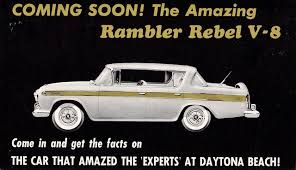
The crowd continued to thin. We helped strike a tent next to an extraordinary example of 1957’s performance Rambler, the Rebel. Dr. Bill Lenharth was the proud owner, and he was eager to show Dad the fruit of his labors. We examined the car from every angle, We were informed about the trade-mark crack that happened to all Ramblers at the shoulder of the top, due to a “soft Joint” that always resulted in distortion. We looked at the engine, and we got the postcard featured at the beginning of this note. That wasn’t all we got, though. The good Doctor- or maybe the Mad Doctor- wanted Dad to drive the product of his automotive legacy. Dad adamantly opposed the idea. But in the end we found ourselves gliding out of the lot and swerving onto Route 61.
The boulevard there is four lane, crowded and whizzing with the modern descendents of these magnificent machines. I was observing the unique chrome fitting of the Vee-vents on the REAR windows when I detected someemotion in the Doctor’s voice…..and lurched backward in my seat as he stomped on the accelerator and the Rebel shot forward. Now, classic sheet metal, particularly that which is coated in ten layers of opalescent lacquer, is supposed to be venerated, not abused. But not so with this enthusiast!
The Doc surged through a yellow light, throwing us around like ninepins, and tromped the gas again. He wove decisively through uncooperative traffic to detail the finer points of the class of 1957. We caught three yellow lights and nearly sideswiped a Subaru before he decided to hit the brakes, swerve across traffic lanes and do an urgent U-turn across an access road. Calmly looked over his shoulder, he glanced serenely at oncoming traffic, sneered in the face of doom, and floored it.
The tires burned rubber as we merged, and minutes later, we were deposited back in the parking lot.
I smashed my forehead on the doorframe as I exited, feeling grateful to be in a generation that knew these fine automobiles, but no longer had to drive them. What a thrill it was, though, to acknowledge that there beats in some bosoms in the Hills of Pennsylvania, a love for these machines, and from the Live Free or Die State, the willingness to sacrifice all for their passion.
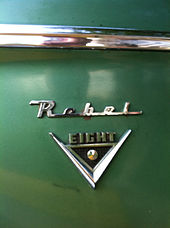
Later, there was a banquet, and a speech delivered by Raven as the keynote speaker. There was a line to have Dad autograph Pat Foster’s book. There was a trophy for virtually everything. They were very nice people indeed. But as Dave Berry noted…..the line between hobby and madness is fine indeed. I saw across it in the backseat of a 1957 Rebel.
Oddly, when I let my son drive the Sebring convertible the few hundred miles back to Washington, he would shout spontaneously, at fifteen minute intervals into the roaring slipstream; “God! Is this cool!”
Car folks are just car folks, n’est pas? But I no longer have to drive Ramblers, even if the seats did fold down. I remember sending away Raven’s last Rambler- but maybe we will have to deal with that tomorrow.
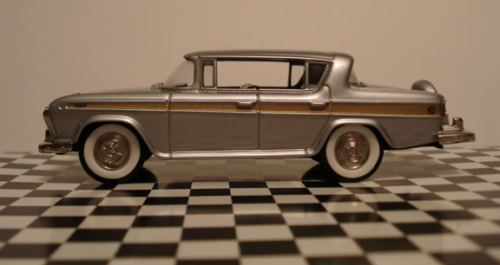
Copyright 2014 Vic Socotra
www.vicsocotra.com
Teitter: @jayare303
Going to the Races
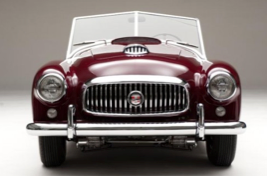
(The very first Nash Healy. It recently went at auction for a cool half million)
OK- we have covered the end of the Big War before and I won’t bore you with it again. Our pal Mac Showers was there, and even was in Japan five days after the surrender. I know what he did- he was the acting Fleet Intelligence Officer when the grown-ups fled the former war-zone to sort out what was going to come next back in Washington.
And as you know, there was a lot. There was a whole economy to transform, millions of people to demobilize from the armed forces, and consumer demand for all the stuff that had been rationed “for the duration.”
Raven was in the third-to-last graduating class in the pilot training pipeline at Naval Air Station Pensacola. In those days, you got your commission as an Ensign the same day they awarded you the Wings of Gold, and along with it came the choice. Most of the early training cadets were just sent home, since there would be no need to invade the Japanese Home Islands.
Sort of an odd thought these days, but drinking with Mac Showers and hearing how the Navy contracted from it’s swollen level was a real eye-opener. Mac elected to stay in and make the Navy a career as an intelligence officer. They offered Dad’s class the option of staying active and going to the Fleet, or accepting a reserve assignment and go home.
Dad decided to go home to New Jersey, attend Pratt Institute’s School of Art and Design, and go into the burgeoning consumer products design field. I don’t know if he was already thinking cars, but his Big Brother designed airplanes, and it would not have been much of a leap.
The 1946 Indianapolis 500 Race featured a 1946 Lincoln Continental as the pace car, showcasing Ford’s return to the expensive and exotic passenger car market after building B-24’s at the amazing Willow Run plant that chunked out a heavy bomber every hour, round the clock, in it’s peak production phase.
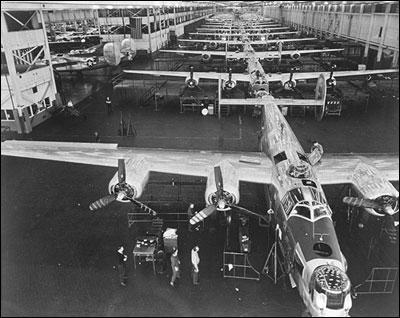
That is the Arsenal of Democracy at work- and it was a colossus that provided all the capacity to build just about anything in whatever quantities were required.
It is interesting to think that the plant capacity funded by the Government’s bonanza of war contracts contributed to the demise of the free-wheeling auto industry- But George Mason at Nash had contributed $37 million in war production to the push to Victory, and when the conflict was done, he was ready to go to the races.
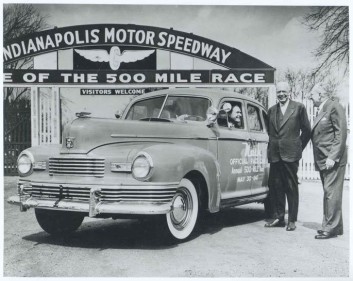
At Indy in 1947 the pace car was a Nash Ambassador, the only time the company would lead the field. A surprising fun fact is that the Ambassador overhead valve six cylinder engine was only 18 horsepower shy of the Lincoln’s massive V-12 engine, (112 horses vs 130 for the Lincoln).
Mason was a man of many parts. Industrialist, of course, but also a photographer and fervent outdoorsman. In 1949, he embarked on a trip to Europe to investigate possibilities in England and Italy for innovative design and engineering. The effects of the war lingered in the UK: the beleaguered Empire was just ending the war-time rationing of clothing. He took the elegant Queen Elizabeth, and therein lies the story of the first purpose-built American sports car of the post-war era. You can tell that to those guys in the Corvette club, too.
Racer and auto builder Donald Healey was returning to the UK after a disappointing series of meetings with Generous Motors execs in Detroit. Healy had a vision that would resonate down through the years of the Giant Engine harnessed to a Little Car. The Cadillac 331 V8 engine featured a “dry” open runner in which coolant exited through an assembly attached directly to the cylinder heads- it required use of a tappet valve cover on intake manifold and a rear-mounted distributor and featured shaft-mounted rockers. It was viewed as the state of the art, and GM sniffed at the idea that Healy would stuff them into an allow-bodied sports car.
Crestfallen, Healy was returning home to consider his options when he met George Mason on the great transatlantic liner. Both men were interested in photography, and as their friendship deepened on the passage, they began to talk of their other passion- fast cars.
They two agreed that motor racing was a necessity in the development and promotion of a sports car, and what’s more, Mason thought his Ambassador engine would be perfect to power such a car.
Healy’s vision was of a sleek lithe, lightweight alloy-body fabricated by the British firm Panelcraft, spare styling and interiors, and speed to burn.
The Nash-Healy designed from the very beginning to after the very best racers in the world. With the engineering genius of England’s master car designer and the backing of Mason’s Nash Motors, it was entirely possible that they could put together a world-beater. As soon as first prototypes were ready, they began to appear on the racetracks of the world ready to take on the very best.
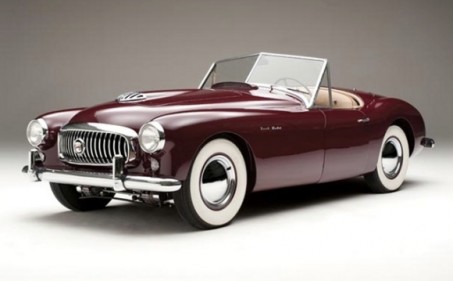
Yes, that little Nash Rambler was ready to stomp on it.
June of 1950: Le Mans, Nash Healy versus Talbot, Ferrari, Jaguar, Aston Martin and Allard. The last of those famous marques is sporting the gigantic 5.4 liter Caddy engine that Donald Healy could not get for himself from GM.
After 24 hours of racing the checkered flag waved wildly as the Nash-Healy roared past in fourth place, behind two Talbots and an Allard, driven by the legendary racer Sidney Allard himself. The brand-spanking new Nash Healey made a huge statement in the biggest racing event of the year.
In celebration, George Mason authorized production for domestic sale of the international car as a halo vehicle for his Rambler and prospective sub-compact Metropolitan.
It worked. In 1951, the Nash Healy placed a respectable sixth at Le Mans. In 1952, the Nash-powered Healy streaked to third behind only two lavishly-funded Mercedes cars.
In addition to its record at Le Mans, the Nash-Healey competed at the famed endurance drive of the Mille Miglia, finishing as high as 30th (out of over 400 entries in 1951) of 173 finishers. Nash-Healeys also competed there in 1952 and 1953.
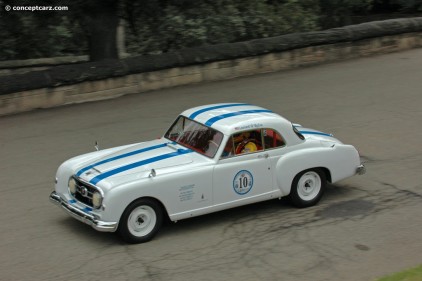
(This 1953 Nash Healy is dressed to campaign. Image ConceptCars)
You would think that this heritage of racing success would translate direct into sales, but the vast manufacturing capacity of Ford and General Motors prompted a frenzy of cost cutting as Henry the Deuce decided his family-owned company could pass GM as the world’s largest automaker.
The collateral damage to the smaller manufacturers was devastating. In the case of the Nash Healy, shipping costs were a major component of the MSRP. Engines and drivetrains had to be shipped from the plant in Kenosha, Wisconsin, to England for mating with the Panelcraft and Healy-fabricated frames before being put on the ship to return to the US.
The sticker price for the Nash-Healy was a little short of $6,000. Generous Motors put the price point for the new Chevrolet sports car- the Corvette- at fifteen hundred less, an enormous differential in 1953 bucks.
The bean counters had their way with the lightweight alloy bodies. In 1952, alloy was out and cheaper steel was in. The steel bodies were fabricated by Pininfarina in Combiano, Italy, and the headlights were moved from the fenders inboard to comport a family resemblance to the placement on the Rambler Ambassadors.
Longer and wider, the tail finned, beauties were glamorous, but had “road hugging weight.” They could not hold a candle to the Panelcraft alloy cars, which were the ones that competed so well. Only one hundred and four of the alloy Panelcraft production cars were built, and according to the Nash-Healey registry, only twenty are still accounted for and of those, only seven have been restored. as of today 20 are accounted for. Of these 20, seven are in operating condition.
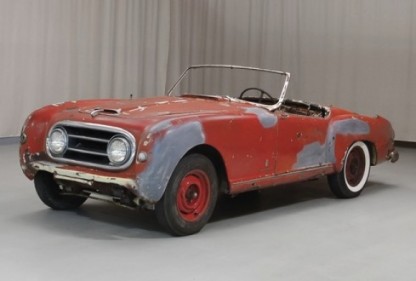
I don’t care. I think the goggle-eyed 1952 and ’53 models are still cool. Price killed them, and the last of the 1953 production models were sold as 1954s, but George Mason’s day at the races was done. He was still convinced that the transatlantic connection could work, if he found the right product.
In 1954, he brought the first of the cute little Metropolitans to sell in America, and Dad got one of the first. I mean, cute as hell, but one thing was for sure: no one was ever going to take one to Le Mans.
Copyright 2014 Vic Socotra
www.vicsocotra.com
Twitter: @jayare303
Mason and Nash
My pal in Monterey filled me with envy the last few days. Car Week on the peninsula is starting, and there were at least three events already with the auctions starting today. The wildest one was:
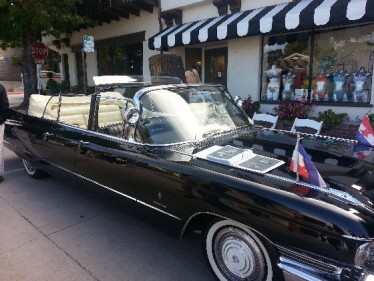
(“Big Daddy’s Caddie” ! … Big Daddy being Josif Broz Tito…. it reportedly was a gift, a token of esteem from….. the U.S. Govt., President Ike specifically…. 1960 custom job sold for $165 k recently…”Who’d a thunk it? Marshall Tito was a Car Guy. Photo Jim Mueller)
I was going to write about the Nash-Healy this morning, the “first post war purpose-built sports car,” but the whole day got away from me. Not my fault- I was intensely busy doing…well, I am not completely sure. But it certainly occupied my time.
The Healy had a special place in Dad’s heart. He had just moved over from Ford’s to Nash-Rambler to join George Mason’s team of eager (and talented) designers.
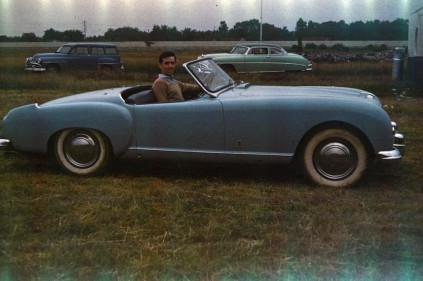
(Here is a contemporary mid-1950 picture of Raven at the wheel of what I think is a 1952 Nash-Healy roadster- the headlights have been moved from the fenders to the bug-eyed Rambler configuration on the grill, or so I surmise from the fenders. Photo WER).
Taking about the Healy would mean having to talk about the unlikely confluence of events that brought the car to life, which would include the equally unlikely story of George W. Mason.
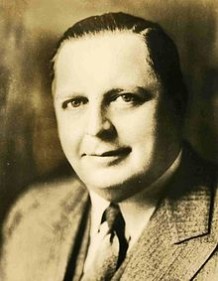
(George Walter Mason in his prime).
Mason hailed from Valley City, North Dakota, a little town on the Sheyanne (no, it’s not a typo!) River and one of the railroad towns that appeared with the transcontinental railroad system. The Hi-Line Bridge there that served the Northern Pacific Railroad was an engineering marvel, and might have inspired the young Mason to want to become an engineer. As a youth, he had jobs at a couple of the local garages, fixing cars and agricultural machinery.
He did so at the University of Michigan, my university, though Mr. Mason studied something useful while I did not. He was a thoughtful man even when he was young- his contribution to the American industrial miracle was devising an undergraduate degree that featured three years of engineering studies capped by one of business management.
It was a revolutionary concept, mixing sound business practice with solid engineering. It helped product a generation of well-grounded entrepreneurs.
Detroit was just up the road from Ann Arbor, and Mason was interested in the emerging auto industry and his cars first job out of school was at Studebaker. He bounced around the growing new industry before serving in the Great War.
After demobilization he was hired in 1921 by Walter P. Chrysler at Maxwell-Chalmers, which the energetic industry titan was developing the brand that would carry his name for a century.
Mason moved over to Copeland Products in the Roaring Twenties Motor City until he was hired away to become President of the Kelvinator Corporation, a leader in the parallel miracle of technology to the automobile, electric refrigeration.
Mason’s astute business sense helped quadruple Kelvinator profits, and guided the company to grow to number two in the industry, second only to the Frigidaire brand owned by Generous Motors.
Sometimes it helps to be in the right place at the right time. Refrigeration for food preservation was a solid business, even in the depths of the Great Depression.
Mason’s success amid the gloomy economic times made him a prominent industry star. When Charles W. Nash, of Nash motors, was looking to retire, he asked Walter Chrysler for recommendations to replace him. Chrysler responded that of course it was George Mason.
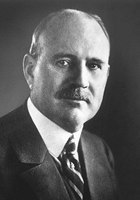
(Charles Williams Nash).
Just a word about how incestuous all this was. Nash had co-founded Buick just after the turn of the century with future Generous Motors icons David Buick and William Durant, and became Buick’s general manager in 1908.
Two years later he was hired away to salvage a debt-ridden GM, and returned it to profitability by 1914.
His insistence on plowing profits back into the business, rather than distributing them as dividends led to a stockholder revolt and he was unseated by former partner Durant in a company coup d’etat.
Nash then resolved never again to work for someone else. He bought out the Jeffery Motor Company in 1916 and renamed it for himself the next year. By 1919, he had sales of over 30,000 trucks and cars, partly due to the mobilization of industry to support America’s supporting role in the Great War.
In addition to running Nash Motors, Charles Nash was also president of the luxury car company LaFayette Motors until he decided to buy himself out in 1924.
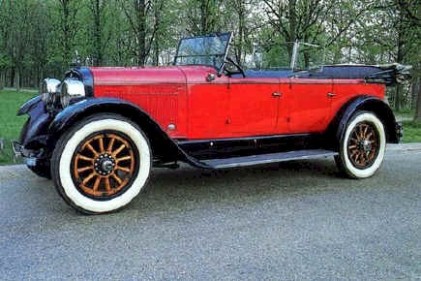
(1922 LaFayette134 V8 Rear Window Touring car. Lafayette Motors, Milwaukee, WI. You could say the LaFayette was the prototype of the Nash-Rambler Ambassador sedan we loved to take to the drive in).
Nash approached Mason to come over to his company and replace him. Mason initially rebuffed Nash’s offer, liking the position in the industry to which he had brought Kelvinator. Nash wasn’t taking “no” for an answer, though and offered to sweeten the deal. He asked what would convince Mason to make the move.
Mason replied, “if you take Kelvinator with me, you have a deal.”
It made sense. Nash saw that the auto industry was diversifying: Generous Motors owned Frigidaire, the transmission giant Borg-Warner Norge Appliance, and Walter Chrysler has added an air conditioning division to his empire, Airtemp.
The deal was announced in November 1936, and the merger formed the Nash-Kelvinator Corporation with George Mason as CEO. By 1940 and the years of the big defense build-up, Mason continued to grow Kelvinator’s market share and returned the Nash auto-trade to profitable status.
That was the company that Dad joined in 1950, and he met George Mason on many occasions, even though he was just a stylist and clay-modeler. Mason had hired a very talented young man named George Romney as his deputy, who was going to make history in a couple different career fields.
The reason I am not going to get around to telling you about the birth of the first post-war American sports car today, nor the fact that Dad went the other way from George Mason, leaving the Rambler auto styling shop to head up Kelvinator’s design studio.
We will have to see if we get around to that tomorrow. If I have time. It is so darned busy, you know?
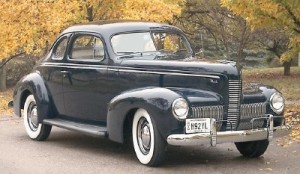
(1940 Nash Ambassador. Pretty sharp ride for the pre-war era).
Copyright 2014 Vic Socotra
www.vicsocotra.com
Twitter: @jayare303
Cars (In Our Lives)
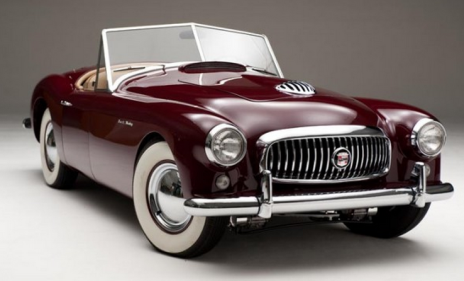
We get letters. I intend, when we put the book together out of these wandering stories, to intersperse the chapters with the accounts of other Great American Car people. Above is one of my passions- it is the very First Nash Healy that just went at auction for a half million dollars. My pals have had their own stories to tell, and here they are:
Apropos British cars, I have had several rebuild projects over the years – a 67 Triumph Spitfire and a 72 MG. Repaired their rusty body parts, replaced their rag tops and replaced various drive train parts to withstand my aggressive driving style. Parted with the Spitfire in Key West, when I got orders to Monterey’s Naval Postgraduate School. I still miss that car. It was a blast to cruise the Keys with the top down and one or both of my daughters in the car.
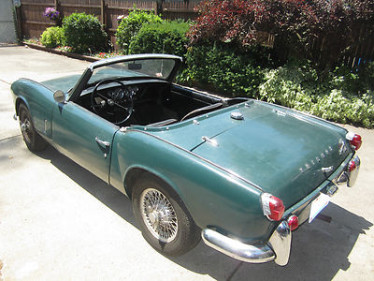
18 months later I bought an MG Midget in Hawaii. It was a project car with body alignment and electrical problems. Fixed the body alignment issues first, since the driver’s side door would fly open when cornering hard and I was not a seatbelt wearer in those times. Its Lucas electrics stumped me periodically during the 3 years I owned it. Every now and then, I would be driving down H2 from Mililani town for an 0-dark-30 midwatch, and the lights would turn off and/or the wipers would shut off. I don’t miss that car.
If Vic recalls, one of our mutual friends, Grey, owned a mustard yellow XKE 2+2 coupe 12 cylinder with 6 Stromberg carbs. The Brits made this high powered machine, since their 3.8 and 4.2 liter engines had been emasculated by the growing attempts by governments to reduce car exhaust pollution. As you’ll recall, these roadsters’ carbs required frequent tuning and rebalancing (all Brit sports cars shook badly). We would tune and rebalance the carbs by ear and feel. It was a beast – we had it over 170MPH on H1 westbound after one tune up, after rocketing down H2 at well over 120. It was the fastest journey to the beach at NAS Barbers Point I ever made. Sadly we had to slow down as the front end got a bit loose, wandering to and fro at the high speed.
One short story about this Jag: Grey’s then wife and true blond, June, used to commute in it to her job in Honolulu. The XKE’s accelerator pedal got stuck one morning as she cruised eastward on H1. She eluded crashing into other commuters by weaving through traffic as its 12 cylinders were starting to roar. Unable to slow it down, she panicked when the car went faster and faster. Not knowing that all she had to do was turn the ignition off, she stomped on the brakes as the car rocketed past 100 MPH. She lit up all four disks to bright orange and smoked all four new tires past their safe use and eventually ground it to a halt. The ensuing damage took a long time to report due to the long wait for parts out in the middle of the Pacific.
Man, I loved that car.
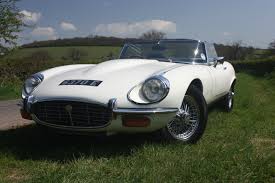
BTW, my father, the Ensign, had a 72 green Cougar V8 that he kept for 13 years. Was that car fast! He sold it in 1985 for more than he paid for it in 1972.
Marlow
————
Vic:
Considering the topic of the day (Concours d’LeMons) I wanted to pass on this photo of my own lemon from my early driving experience. This was my 1972 Pinto which Dad purchased for me from a friend of his. It was a rather nasty green color that was slightly metallic and matched nothing in nature that I know of. This was during the time that the gas tank issue was unknown (at least to the general public) so I drove it as hard and fast as I could without much thought to how safe it was (or wasn’t). Anyway, it was not a peppy car so I added the side striping and aluminum wheels which, of course, added, at least, a psychological 30 HP. As it turns out, this was one of the lemons of its day but, admittedly, it was lemonade to me. It is pictured here parked in front of the Admiral’s house in Arlington. The Olds Cutlass in the driveway was sister Donna’s ride.
Mike
——————
Vic, you got me thinking. How is this for phases in life?
As a kid growing up:
– 1947 Pontiac 2-door two tone grey.
– 1951 Ford (whiskey runner style) 4-door metallic brown (thinking it was metallic). Father was t-boned in it. It was so demolished that he put me in through a back window to retrieve some small items.
– 1952 Ford 2-door pea green. The only thing they could find at the beginning of the model room to replace the 1951. Basically ugly.
– 1956 Chevy 4-door bought used (high school driver ed car) in 1957. Two tone yellow and olive green. First car I drove. Stick shift as all of the others.
As a high schooler and college kid:
– 1962 Rambler American 4-door metallic blue base and white top. 327 automatic with push buttons.
– 1963 VW Bug. Red. Jacoby’s go to two cars with this guy in high school. Sales price of about $1800. Staple of transportation at college moving toward being my car on campus.
– 1966 Plymouth Valiant convertible. Silver with black top and interior. Not sure what got into my father with a convertible. Used it some. Automatic and a dog, but good-looking and practical. Sisters now driving.
– 1967 Plymouth Belvedere (I think) 2-door silver with silver interior. Nice looking car with a big V8 engine. Not sure what got into my father. Family needed multiple wheels with three kids driving.
As law school student and Ensign:
– 1965 Plymouth Barracuda 2-door with hot house glass rear window. White with 3-speed Hurst shifter, but a six. Great car and distinctive. Sold to a used car guy in San Diego the day before leaving on cruise for a little bit of cash in 1970.
Post cruise/Vietnam:
– 1973 Toyota Celica 2-door 4-speed. Gold with mag wheels. Great little car. Peppy. Essentially a two-seater. Only one with a name, “Little Guy.” Lots of memories. The first car I actually bought. Sold to Bill Armbruster in 1979 for his oldest son.
Married and practical:
– 1977 Toyota Corolla 2-door hatchback 4-speed. Green. Very practical and not a bad drive for me and Celia. Paired up with the Celica. Eventually sold to one of my sailors in about 1983. Someone totaled it for him.
Graduating to disposable income:
– 1967 Austin Healey 3000 bought in 1979 from a LCDR at C2F just before I transferred to D.C. and Detailer Shop. Metallic brown upon purchase. Originally black. Restored color and other portions. Wonderful. Sold to a Brit just before transfer to Hawaii in 1990.
– 1980 Mustang 2-door. Small engine. Metallic auburn with matching interior. Dog. Traded at a loss. The only car I ever owned that I didn’t like and didn’t keep for an extended period.
– 1983 BMW 325 2-door 4/5-speed (can’t remember). Tan with chocolate interior. Wonderful car. Traded for another BMW in 1989. Thought I was something being able to afford a BMW.
– 1982 Mazda RX-7 5/speed. Silver with red interior. Bought in 1983 from Holly Vaughn before her transfer to Naples. One of my favorites. Kept it until 2000. Went to Hawaii and came back with us. Couldn’t part with it.
– 1989 BMW 525 4-door 5 speed. Black with grey interior. My absolutely favorite car in terms of handling and smooth ride. Went to Hawaii and came back with us. Had it until retirement in 2005. Like the RX-7, it went to Salvation Army as a donation.
– 1998 Porsche Boxster convertible 5-speed. Silver with blue interior and top. Kept it until 2013 and traded up. You know it.
– 2000 Subaru Outback 4-door. Metallic black with black interior. You remember it. Great car. Sold to Larry R. at time of purchase of present 2011 version.
– 2004 SSR Trick Truck. 2011 with 19,000 miles. Purple. Four speed automatic. Totally impractical. Truly an example of excess disposable income.
– 2011 Subaru Outback 4-door. Metallic black with tan interior. You know it. Fine basic transportation and tailgater.
– 2013 Porsche Boxster S convertible 6-speed. White with black interior. You know it also.
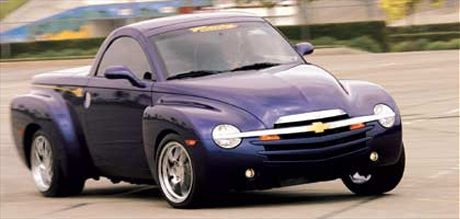
Vic, lots of memories. I keep them and take special care of them. Each is a memory of its own, like each tour is. I can remember dates on tours a bit better than the model years of cars, but they meld together so well. Thanks for the series that brings this all back. Jake.
————
Vic: My Dad turned the Sunbeam Alpine over to me in 1969. Robin’s Egg Blue with black hardtop. I take care of cars. Before marriage only bought two -1975 280z and the 1990 Miata. But the Alpine was too much. Chrysler took over responsibility and they couldn’t maintain it.
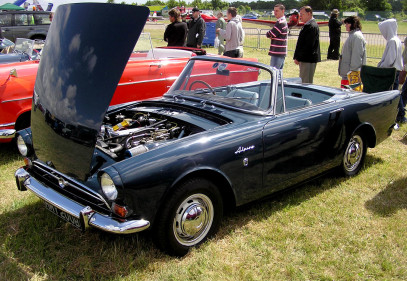
If it weren’t for the electronics-by-Lucas shit, I might still have the Alpine! I had to carry a screwdriver to jump the solenoid. Loved that car. Small, but great fun…
Funny, my current BMW has no frame on the windows and the windows close an inch or two when you hit the button to open it. They call it “comfort access.” Have not figured it out yet!!
————
Sid’s Charger: BTW, my Charger was the standard 318 Cubic Inch V8 – but it was quite adequate. Nancy and I drove it to Germany and back from Finland while I was the NA there, prob 1975, I was the senior U.S. Naval Officer in Finland. We took it easy mostly, but on the way home to Helsinki, we got into a tussle on the autobahn with the usual Porsche, Mercedes, and BMW cohort, and held our own, Nancy mostly with her eyes covered.
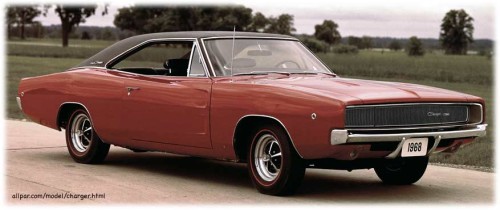
Thanks for the link- I watched the whole 20+ minute Jay Leno piece on the 707hp Challenger. Probably told you previously but my Dad was a partner in the Macon, GA Chrysler/Plymouth dealership when I was in High School and College. I used to work there during the summers (in the Parts Department doing menial labor) and as one who picked up and delivered Chryslers to their owners after servicing (Macon was a small town).
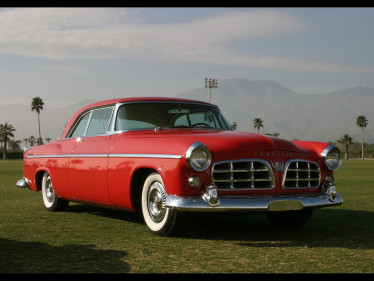
After much begging and pleading, I drove the first Chrysler 300 delivered to Macon in 1955, as soon as it was off loaded from the carrier and cleaned up/serviced for placement on the showroom floor – with my Dad’s assistant (Dad was the service Manager) as “chaperone” to make sure I didn’t total it.
“Boonie” Bush and I went to a semi-quiet part of “downtown” Macon and he gave me the wheel. I was 20. As soon as I got in the driver’s seat, I floored it and we went flying down the street.
I had read all the pre publication information on what a barn burner this car was to be. It was WAY more than I had anticipated and within seconds Bonnie was screaming at me to let off. Scared me to death. I gladly relinquished the con and let him drive us sedately back to the shop.
I’ll never forget those few seconds.
Best – Sid
Copyright 2014 Vic Socotra (and Pals)
www.vicsocotra.com
Twitter: @jayare303
Good Morning, Bloomfield Hills
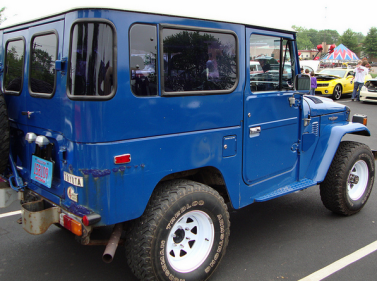
OK, I am stunned. I don’t know if you are- I mean, the guy was a force of nature, manic almost, and if he wasn’t exactly your cup of tea, he was definitely a distinct and vibrant brew.
I was going to present some recollections of car people this morning, but I am rocked back on my heels and will have to defer that. I will get to the why of the impact in a minute.
My favorite Robin Williams role? No, not the dorky “Mork and Mindy.” It was his portrayal of Armed Forces Radio and Television Service’s maverick DJ in Saigon, Adrian Cronauer. His performance resonated with guys of a certain age on a lot of levels.
The looming presence of the war in Southeast Asia for all of us of draft age is part of it, of course, and later those long nights on shift in the Alert Center at Yongsan Garrison in Seoul with only A-Farts spinning discs to keep us connected back to The World.
But there is much more, of course. See, Robin and I shared not only the same birth year (the Rabbit) but we learned to drive on the same streets. My first big ticket was not far from where he lived. I was a Gemini baby, a month older than him. He was a Cancer, born under the water sign of The Crab. Cancers are said to be highly emotional, caring, generous and intuitive, if you believe that stuff.
I came into the world in Detroit, inside the city limits, and he was born in Chicago, where his Dad was a senior Exec at Ford’s Midwest Regional Office in Downer’s Grove west of the city. In those days, execs split their time out in the real world and at the stratified HQ culture of The Glass House in Dearborn.
Robin William’s father was emphatically a car guy.
He never talked much about his family, but did give some insight on the culture from which he came. His Dad got pissed when Robin bought a Japanese car- a Toyota four-wheel Land Cruiser like the one above. In an interview with the Chicago Tribune, he recounted this exchange:
“I remember I bought a four-wheel drive Toyota, and he went, “By God, you buy American!”
“But, Dad, they have dead rats in their engines.”
“Shut up and buy American.”
When the family came back to Detroit they rented a palace at the corner of Woodward Avenue and Long Lake in Bloomfield Hills, which according to a 1996 interview, “was little short of a fairyland.”
I remember those houses, the ones that were so vastly different than the little starter places in Grabbingham. Williams said “It was a giant, beautiful old mansion, with a gatehouse, an empty garage with room for twenty-five cars, barns, and there was a very wonderful old English man, Mr. Williams, who looked after the gardens…the first house, it was so wonderful, so peaceful. There was no one for miles around. Only this giant golf course with people named Tad whacking the old ball.”
In the interview, Robin launched off into a caricature of a preppy fellow named Tad, whacking the old ball and muttering upper-class inanities at the Bloomfield Hills Country Club. My ex-Father in Law was a member there at the zenith of his career in the specialty steel business. It was a very posh place with limited membership so there was never a problem for the automotive execs to get a tee time.
Williams was of the upper strata of the Detroit car culture. He did not go to Bloomfield Hills Lahser high school, which is where the Hills kids went to public school, much less Earnest W. Seaholm where I did, though it was just a couple miles away. He was in the Class of ’69 (we loved spray-painting that on garages) at Detroit Country Day School.
People Magazine- the first time the Socotra has sourced a story to that publication- reported back in 1991 that William’s Academy Award Winning portrayal in Dead Poet’s Society was largely based on a teacher he had had at Country Day.
Robin was President of the Senior Class, played varsity soccer and wrestled. We public school kids would have loved to have competed against the private school kids- it would sort of been a reflection of the larger culture of the Little Two auto companies against GM, Ford and Chrysler.
Michigan left its impression on Williams, though he lived in California for most of his life after the family moved there. I don’t know what happened to his Dad to cause him to throw over the Glass House life for Marin County in the Golden State, but once out there, Robin un-buttoned his preppy shirts and fell in with the artistic crowd, leaving the car culture behind.
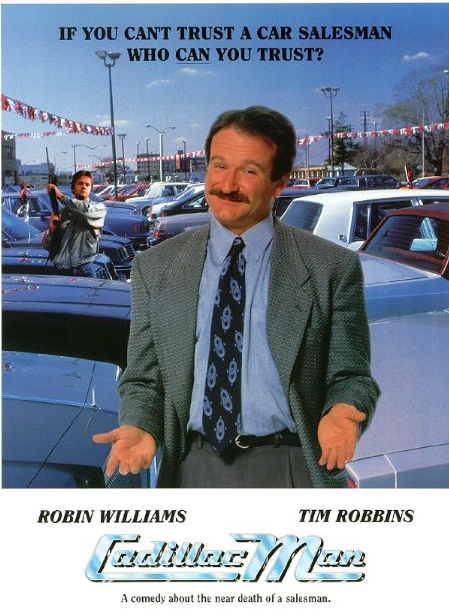
He remembered it pretty well, though. One of the movies you will not be hearing about this week is Cadillac Man. Robin played a GM salesman (you can’t imagine this as a Lincoln dealership, right?) with a complex life. The reviews mostly panned it, though the cast was extraordinary. Robin played Caddy salesman Joey O’Brien, who is having a horrible, no-good, very bad day. He has to sell a dozen cars before closing or he loses his job. He has a rebellious teenage daughter, a irate Ex, a married woman, and an ambitious girlfriend in his life.
Comedy meets drama as the husband of the married woman shows up at the dealership with an attitude and an assault rifle and holds staff and customers hostage in an effort to find out who’s been sleeping with his wife.
Trying to take charge of the situation, the synopsis says “Joey attempts to find a way out of the armed struggle and slowly recovers his self-respect when dealing with all the un-raveling aspects of his life.” The critics said at the time that Robin could not quite pull it off.
So maybe Cadillac Men is a better movie than anyone knew at the time, since that is the way it worked out in real life. In the end, I am sort of stuck with the concluding lines of the Edwin Arlington Robinson poem we learned- probably around the same time Robin did- entitled “Richard Corey:”
So on we worked, and waited for the light,
And went without the meat, and cursed the bread;
And Richard Cory, one calm summer night,
Went home and put a bullet through his head.
Of course, none of us in Grabbingham ever went without anything, though we did have to work. But you get what I mean. No kidding. Robin Williams, Academy Award winner, celebrated on the various continents, wealthy enough to buy all the cars he wanted, and he killed himself.
That is why I am so spooked. I don’t mind celebrity passings, but he was younger, better looking and had it knocked. The rest of us still have to get up in the morning and pretend to look interested. Jesus.
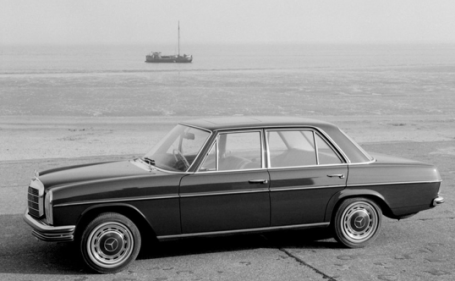
(This 1968 Mercedes Benz 114, driven by its owner, David Zammit, ferried Williams around while they were filming on the island of Malta in the Med. It is as close to a cult car as I can find associated with Robin. Maybe he had enough of Detroit to last the rest of his life).
Copyright 2014 Vic Socotra
www.vicsocotra.com
Twitter: @jayare303
Concours D’LeMons
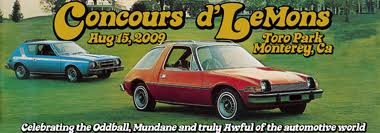
(Flyer for the 2009 Concours D’LeMons. I include it mostly because we had several Gremlins and my Brother owned a Pacer, which lasted until he cut the rear roof off to convert into a make-shift pick-up truck which he thought he needed at the time. Photo Concours D’LeMons).
This has been an extended love-song to the American way of Car Life, but there is a sordid underside to our impassioned affair. If you have not been associated with a car that made you embarrassed and infuriated, you have not been a real Car Person.
I have mentioned Uncle Dick the Bomber Pilot, whose experience in the skies over Europe had a lasting impact on the way he lived his life. He had a fierce independent streak, and his war experience only reinforced it. He strove never to live closer to the place he worked than sixty or seventy miles- maybe further. To accomplish this act of social defiance, he first drove Packards, but was always on the lookout for something elegant, powerful and hot.
That showed up in the shape of the 1961 E-type Jag, sporting the 265 bhp, 3,781 cc DOHC inline six-cylinder engine with triple SU carburetors, four-speed manual gearbox, torsion bar independent front suspension, coil-spring independent rear suspension, and four-wheel hydraulic disc brakes mounted on a 96-inch wheelbase.
No less a luminary than Enzo Ferarri himself pronounced it the “most beautiful car ever designed,” though I think he said it in Italian.
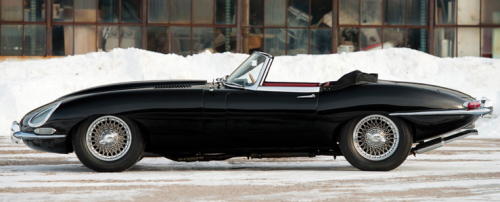
My cousin was coming back home for a visit, and Dick picked him up at the airport. Walking through the parking lot, they passed a Jaguar XKE 3.8, one of the first in imported to America. They stopped to “ooh and ah” about the sleek lines. Those Jags- later offered with a 4.2 liter power plant- were the sleekest cars of their day. My cousin was probably not particularly surprised to discover that it was his father’s new car. They got in and drove off.
A car that beautiful had to be perfect, right? Dick was as uncompromising about his cars as his heavy bombers. Something was not right in his new ride, and he took it back to the Dealer to ask what was wrong- the vibration from the engine compartment reminded him of a failing engine on the way to the target IP over Germany. The Dealer responded that it was the same with all of them- a slight casting defect in one of the cylinder walls. All was perfectly all right, he said, “You just have to baby it for several hundred miles until it was properly broken in.”
That was unacceptable for something so beautiful. Dick eventually went Corvette and BMW, along with the Syclone truck for bulk-hauling duties that needed 0-60 ETs in the mid 4 second range. But I think it is safe to say that anyone who flogged a British car with electronics by Lucas learned how to curse.
And walk for help.
So, with the beautiful came the bad, and that doesn’t even scratch the surface on some of the rolling junk we drove. My ’73 Vega engine was a case in point- a car I liked, but which clearly was not ready for prime-time. That does not get to the subject of the astonishing offenses to esthetic values represented by Soviet Bloc automobiles- ugly things built by disinterested workers, like the GAZ Volga or the Lada family, much less the appalling travesty of he Econobox era of car-building, as the American competitive advantage diminished against the implacable (and high-quality) Japanese and their successors.
I had a pal who jettisoned his 1980 Mustang 2-door at a loss. “Small engine,” he said. “Metallic auburn with matching interior. A dog. The only car I ever owned that I didn’t like and didn’t keep for an extended period.”
We have all been there. After all, I come from a family that had three- count them- three AMC Gremlins and a Pacer. I know the pain of having to transport oneself in a manner simply not acceptable to any real car person. And yet, even the ugly got us around, and are very much a part of the American Dream and collective nightmare. There are those who celebrate this aspect of the Car Experience.
In California next week (16 August) the Concours D’LeMon will occur again. The words of the organizers give you an idea of the spirit of things:
“An ugly oil stain on the Pebble Beach Auto Week, the Concours d’LeMons returns once again to Laguna Grande Park in Seaside, CA. Hoopties, Rust Buckets, Misfits, Mistakes and the worst of the automotive world will be on display and as always, celebrity judges will be accepting bribes for our Thrift Shop-sourced trophies.”
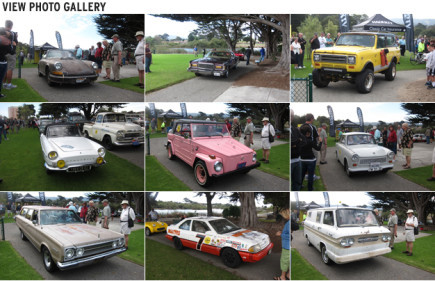
(A celebration of quirks, oddities and individual liberty at last year’s Concours. Photo Hagerty Insurance).
A business concern called Hagerty Insurance has inexplicably sponsored the the debacle yet again, so the organizers say it is really all their fault. This is a determinedly down market affair, and is free for participants and spectators who get exactly what they pay for.
Show categories include Vegas, K-Cars, and Pintos, Marlins and Barracudas, and special foreign collections, termed “Needlessly Complex Italians,” “Kommunal Kommunist Kars,” “Soul-Sucking Japanese Appliances,” “Unmitigated Gauls” and the baleful best: “Rueful Britannias.”
Somebody has to celebrate electronics by Lucas, you know?
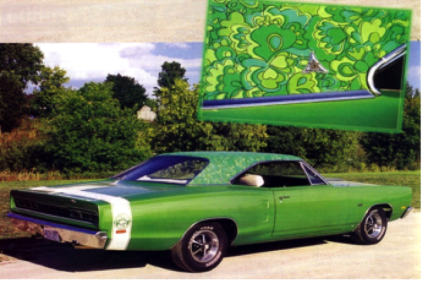
(1969 Dodge Super Bee with Mod Top option. Photo andy440.com).
There is even special commemorations for things that could screw up even cool Detroit iron, like the Mod Squad vinyl roof, which I think the vast majority of car people will agree are “the work of Satan himself.”
And what if you weren’t a Mopar fan in the early 1970s, but you still wanted in on the gaudy fun? Worry not, because you could’ve strolled into your local Ford dealer and ordered a Mustang Grande or Mercury Cougar with an ultra chic houndstooth vinyl roof. There’s even a rumor that a few Pintos were optioned with a paisley print vinyl roof of their own.
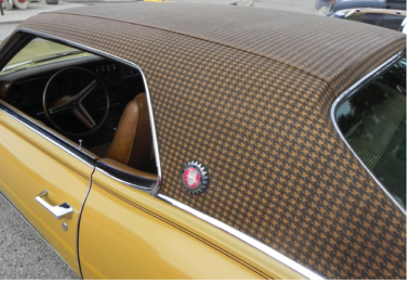
(1970 Mercury Cougar with houndstooth vinyl roof (photo credit google.com)
According to Concours commentators Rotten Gas and Rusty Wishes, it is like an English Bulldog- “It’s so ugly, how can you not love it? Thank you, Ford and MoPar for taking the reviled vinyl roof and making it so unbelievably ghastly, that somehow it actually went full circle and became cool again.”
I could go off on the Marlin Florida edition coupe, but I am not going to.
Actually, some of these daily drivers and beaters are actually sort of cool, since we didn’t have the capability to drive a Shelby A/C Cobra or have an Auburn commissioned with custom coachwork. And mostly likely, we never will.
It is the Concours D’LeMons, the cars of our lives.
Copyright 2014 Vic Socotra
www.vicsocotra.com
Twitter: @jayare303
Concours
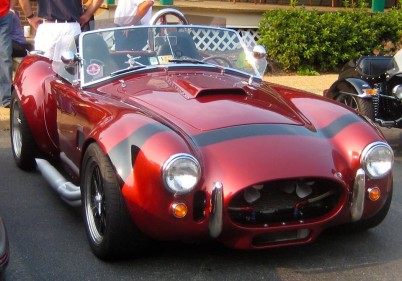
(Shelby A/C 427 Cobra. For me, the coolest muscle car affordable- sort of – to the common man of all time. Photo Socotra at Katie’s Cars & Coffee at Great Falls, VA).
It is August, and the cars are out all over the country. There are shows all over and as I typed the date this morning, I realized I will be at the 13th annual Bill Reddig Regional AMC Car Show in less than two weeks. The road is starting to call. The event will be held at the Grissom Air Museum 1000 W Hoosier Blvd., Peru, IN., 46970, where the classic cars will be parking amid the static display of gallant old warbirds.
Just a gentle reminder- registration ($15) is between 9 am – 11 am. People’s Choice awards are at 3 pm.
Remember, AMC parts vendors are welcome at no charge.
I also got some feedback from folks who regularly attend weekly informal shows in their hometowns. They are the lifeblood of car people and their rolling hobbies. A regular correspondent from Rancho Santé Fe in San Diego informed me that there is one in the village every Saturday morning- which she likes to visit if she needs to go to the Union Bank.
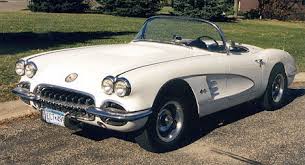
She is a Car Gal- she wishes she still had her 1958 Corvette convertible, which had “the black plastic hard top and white soft top. When I put the soft top away for the winter I used tissue paper to secure it.”
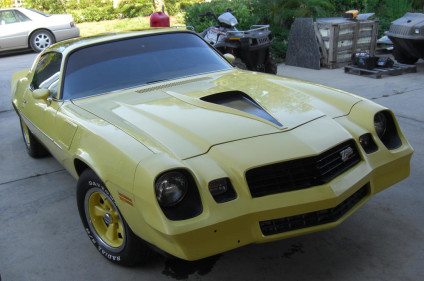
It is about love in a way that is quite profound. An able writer from Utah remembered her two named cars- a VW Beetle named Nelly and a yellow 1978 Camaro T-Top named “Sunny.” And the fact that none of the eminently practical Subarus she has owned since ever got names.
In the flood of mail, I got a mildly chastening note from Baha California that suggested I was being snide about the Cars & Coffee origin story from Southern California. I hastened to respond, stung to the quick. I am as nuts as anyone about cars, and all of mine have had names.
You should have seen my eyes when I came across another 1991 Syclone pick-up at Katie’s- I then had an emotional owner-to-owner exchange with Danny-the-Owner, who has 130K on the odometer, two mismatched fenders, and has been racing and tinkering with the truck since 1994.
One interesting thing I found about Great Fall’s car people- there is a significant foreign component to the crowd, one that is distinctly South Asian and Middle Eastern in origin.
That fact should not be surprising, since we drove the Porsche past the compounds of the Saudi Royal Family and that of the Pahlavis on the way to Great Falls.
And Car People? Check this link to a little show in the Persian Gulf Emirate of Dubai:
https://www.youtube.com/watch?v=1J-DObuH6gc
But to my Baja pal’s comment on California: SoCal made a unique contribution to the creation of the mobile American lifestyle. The people on the Coast re-invented what came out of the dirty plants in Detroit and Ohio and Indiana and Kenosha in a playful, pastel hued manner. It is the Beach Boys and Jan and Dean, after all, who popularized the Love Songs to the carburetor and set us all off on the search for the Endless Summer in our Woodies.
My correspondent in Monterey gently reminded me that there are shows all over- at Detroit, LA, NYC, etc…. “but when you’re talking ‘greatest’… please don’t forget…..our own show starting here next week.. the Pebble Beach Concours d’Elegance….”

It is actually Car Week out there on the lush Monterey Peninsula.
The Concours D’Elegance has been going for sixty years, mostly on the 18th fairway of the Pebble Beach course, and has come to be the finale of other shows and auctions of historic vehicles.
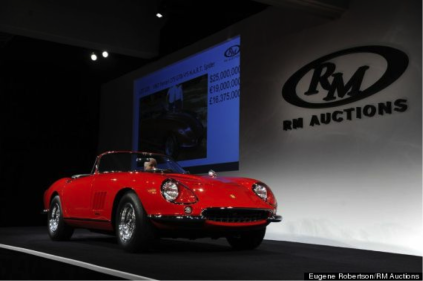
(This ’67 275 GBT/4 Ferrari N.A.R.T. Spider- one of only ten built- went for $27 million at the RM auction last year. Photo RM Auctions by Eugene Robe).
He went on to note that Car Fever runs all down the Big Sur Coast- there are rallies of classic cars and auctions and classic car races at the nearby Laguna Seca Race Track.
The finale of the Concours D’elegance- which he is working, BTW- is now limited to about 175 screened classic cars, rigorously judged by world experts.
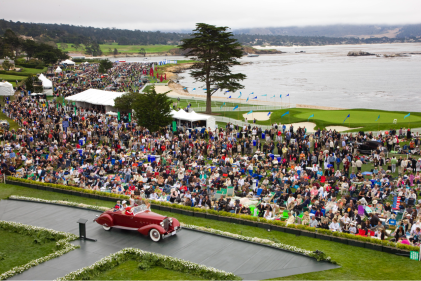
The cars themselves come from five continents and the 15,000 attendees lay out $300 per ticket. It is an impressive tribute to conservation, history, and of course, vast amounts of disposable cash.
I am looking forward to my pal’s pictures and commentary on the event.
But not all of us can afford to drive our Ferraris to Great Falls, or make the cut for the Concours D’elegance or the Hoosier Bill Reddig Rally. Madness comes in all flavors about our wheels.
There is another Concours event in the Monterey Car week, which appears a great deal to me.
Maybe we will get to that tomorrow: The Concours D’LeMons. We have all owned one of those, at one time or another, and may even be driving one now.
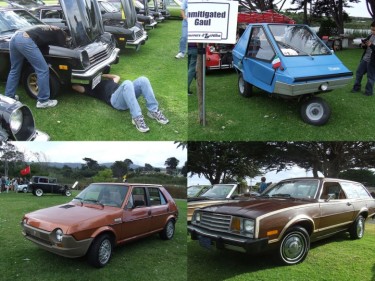
Copyright 2014 Vic Socotra
www.vicsocora.com
Twitter: @jayare303
Katie’s Cars & Coffee
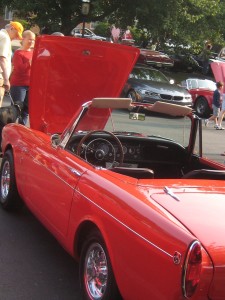
(Cherry Sunbeam Tiger. These little guys ROARED!)
Sorry- this is late, going to get later, and I am so far behind that I think I will defer writing about it until tomorrow. Jake picked me up in the Porsche a pretty cool ride to take to get to any car event, much less this one. We had heard about this as a sort of pop-up phenomenon. Cars from all over NoVA and Maryland (I am convinced there are no real Car People in the District) come to a Katie’s Cars and Coffee.
The people and vehicles are an eclectic mix of old Muscle People, Hot Rodders, European Exotics and American Weird.
There was another Syclone there- which makes two of them in the region that I am aware of. I was knocked out.
Here is how it came to be, courtesy of Katie’s:
It all started in sunny Southern California…
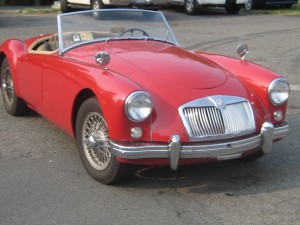
The Genesis – Donut Derelicts
“1983: Long being a community meeting place for old timers to shoot the breeze, four buds started gathering at Adams Ave Donuts in Huntington Beach California to take their sons dirt bike riding and talk politics over coffee and donuts. When one of the guys bought a 57 Chevy panel delivery, it started a revolution. Soon the entire crew found themselves with some old iron and in February of 1985, decided to start meeting at the shop with their cars and add bench racing and sports to their list of morning conversation.
One by one, local street rod owners heard the buzz and started joining in. Before they knew it, every hot rod, street rod, classic and specialty creation from the South Bay to Laguna and parts unknown had heard about the Adams Avenue Donut meet. Their group grew to hundreds every weekend, to include local legends such as Art Chrisman (drag racer from the 60′s), Little John Butera (formerly with Hot Rods by Boyd) and Chip Foose.
It soon became impossible to get a decent parking space if you weren’t out and about during the dark hours of the morning, with all spots taken before 6:30 am. Today you can still cruise in to the “Donut Derelicts” and be amazed by the variety and quality of cars that drop by to join in the largest and most well known weekly hot rod gathering in the world!
From “Donut Derelicts” to Crystal Cove: The birth of the original “Cars and Coffee”
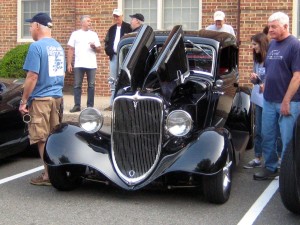
2003: Two former “Donut Derelicts” that didn’t really feel they were a part of the traditional hot rod gathering decided to start meeting “behind the Orange curtain” during the somewhat more reasonable hours of 7 a.m. to 9 a.m. at the Crystal Cove shopping center located on the Pacific Coast Highway just south of Corona del Mar.
What started as a small gathering of high-end gearheads grabbing a cup of joe together on Saturday mornings (enter the first official use of “cars and the coffee”) has morphed into something MUCH larger.. Word of the gathering quickly spread amongst enthusiasts. Former race car driver Dan Gurney and sports car/golf guru Reeves Callaway lived close to the event and started attending. Shortly, the event started to outgrow the size of the lot.
Then the problems really started:
Residents of the $5 Million+ condos overlooking the shopping plaza apparently didn’t appreciate the sounds of Ferrari flat plane crank V8’s or Lamborghini V12’s buzzing at 7am in the morning.
Shopping center security started blocking parking on-site before 7 a.m. This often caused traffic to back up on Pacific Coast Highway – a small fact that was not appreciate by the California Highway Patrol as well as local police.
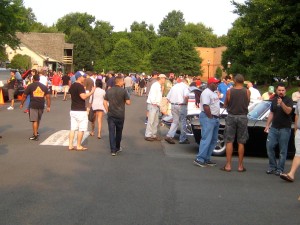
In the end, the Irvine Co. (which owns most of Orange County) succumbed to the complaints from the neighbors, and there was news of an impending eviction of the C&C from Crystal Cove.
The last straw was laid after an incident which had The Irvine Co. security deny Dan Gurney and Reeves Callaway entrance to Crystal Cove. That’s when John Clinard (car collector and head of Ford’s west coast public relations) offered to move the event to Ford’s nearby headquarters in Irvine, California.
The infamous Cars and Coffee Irvine takes Shape and Inspires the World
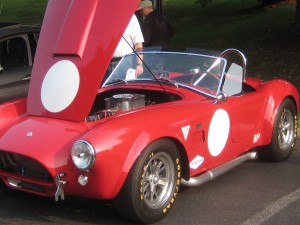
2006: Ford Motor Company stepped up and provided a new location for the Crystal Cove gathering in what was then its large Premier Auto Group (Jaguar, Land Rover, Aston Martin, Volvo) complex.
While Ford moved on (The PAG building is now currently owned by Taco Bell), the event has lived on with Mazda grabbing the baton (at its building in the same non-residential campus) with its huge parking lots used as show areas, and a large parking garage serving as overflow/spectator parking.
While the weekly pilgrimage hosts 100-250 automobiles of all makes and models, it isn’t uncommon to see some of the rarest cars (not just in the United States, but in the world) cram within its hallowed aisles.
One of the few shows where celebrities like Jay Leno have more pictures taken of their car than themselves, both large automakers and boutique manufacturers have caught onto the commotion and often use the lot to reveal prototypes and pre-production vehicles to the public.
With the Cars & Coffee concept steadily spread to various areas across the country, Irvine remains both the original and arguably the greatest weekly automotive gathering in the world.”
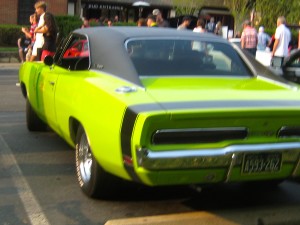
OK, OK, that is all Kalifornia Krap. But the Golden State is what it is. This is about DIMARVA, where the five richest counties in America all collide here around the glittering diamond of The District, one-time capital of the Free World and the place they print all the money. All the pictures from this morning are on my Facebook Page. I will tell you more about them tomorrow, I am afraid.
Copyright 2014 Vic Socotra
www.vicsocotra.com
Twitter: @jayare303
Malaise
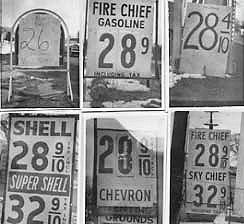
It is Dad’s birthday. He would have been 92 this year, had his fine mind and artistic hand not been dragged down by the shackles of dementia. He was the real Car Guy- he designed them and drove them and lavished us with his passion for them. It has been a wild ride, these last several decades.
By the time we got to OPEC’s extortion, the wisdom of the Georges- Mason and Romney- was apparent. I was already used to driving the pert little red VW Beetle (’68) and the first car I owned new was a Chevy Vega mini-wagon. But that was definitely not what was hip to drive in the late 1960s. The bigger and faster the better.
I don’t think I will ever forget the gas wars that pre-dated “peak oil production” in the sixties. Seems like science fiction today:
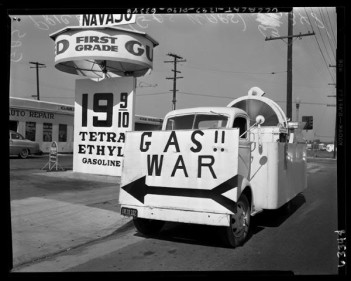
The Draft had ended, and the edgy nature of not knowing what fate had in store after college made us think- diffidently- about growing up. It was not until lately that any of us would think seriously about maintaining the sort of rolling iron that we flogged around town. There is still sentiment about that, and I had to think about that when I filled up the Bluesmobile the other day.
The Police Cruiser only drives around town these days, and when I took it to the Dealer for the 90K check I discovered to my growing horror that it was going to cost half of what I paid for the vehicle back in 2010 to get it back to tip-top shape. Sigh. But repairs are not the only thing that is startling: regular gas is, honest to God, $3.45 at the Class Six gas station over on post.
Premium for the Panzer is scraping four bucks a gallon. I keep the sticker shock to a minimum by topping off frequently, but still.
The Oil Shock gave us odd-and-even days for access to gas of any grade, and long lines during peak hours all the time. There was a sense of uncertainty about everything. I was at the Pantlind Hotel in Grand Rapids the night before the Presidential election to wish Jerry Ford well. The crowds started gathering early in the afternoon to greet the home-town boy.
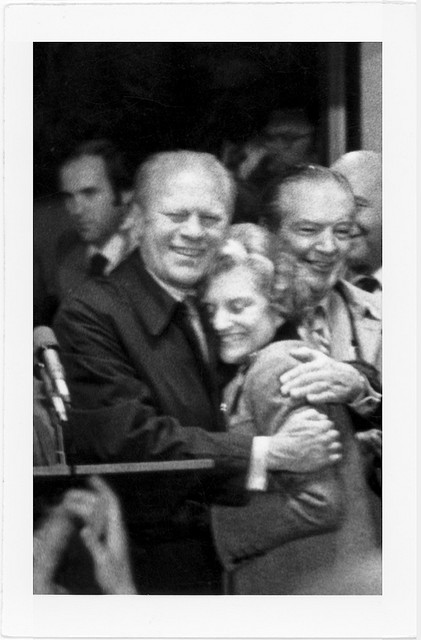
(Jerry Ford hugs Betty at the Pantlind Hotel, election eve, 1976).
It would have been a boring wait- so I walked downstairs to the Gas Light Bar and made myself comfortable with a few cold ones. Emerging from the basement, I was on the presidential side of the velvet rope which was holding back the well-mannered crowd, and if anyone was irritated when I stepped over it and took a place in front, no one said so.
(The Gas Light Lounge at the Pantlind Hotel, downtown Grand Rapids, Michigan).
“We love you, Jerry!” was my first media moment as the President finished his brief remarks, doubtless happy that the campaign to validate his unintended term as Chief Executive was over.
The next morning we voted, and late that night got our first taste of the Carter malaise, which until recently marked the low point in the national mood. But the gas was cheaper.
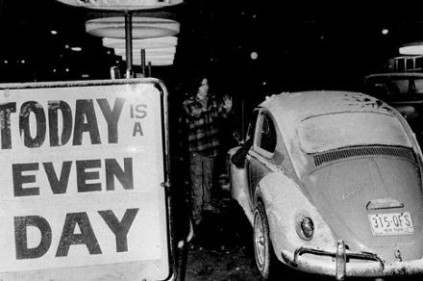
(A typical sign from the 1970’s; which featured such cultural icons as Pet Rock, Mood Rings, platform shoes, 8-tracks, Disco and Spiro Agnew. The music was provided by Janis Joplin, John Lennon, Yoko Ono, the Moody Blues and Eric Clapton).
I don’t think in our wildest dreams we would ever have expected that the United States would become a net exporter of oil and gas again, and completely without the intent of the Government. It is really irritating for those who want to shut down fossil fuels, but it would appear that the 17 and a half year hiatus in warming has cooled the public ardor about warming, and the whole climate thing has fallen to the bottom of the public’s list of concerns.
It seems people are ready for the latest malaise to be over, and they are buying the fastest iron ever to come out of Detroit- again. The interview between Jay Leno and Tim Kuniskis, president and CEO of Dodge, regarding the comparison of the MoPar Challengers of the pre-Malaise days and the Hellcat they are introducing now is illuminating. My Left Coast Attorney, a known car guy, sent it along. It is worth a watch if you haven’t seen it:
http://www.motorauthority.com/news/1093673_2015-dodge-challenger-srt-hellcat-visits-jay-lenos-garage-video
Copyright 2014 Vic Socotra
www.vicsocotra.com
Twitter: @jayare303
